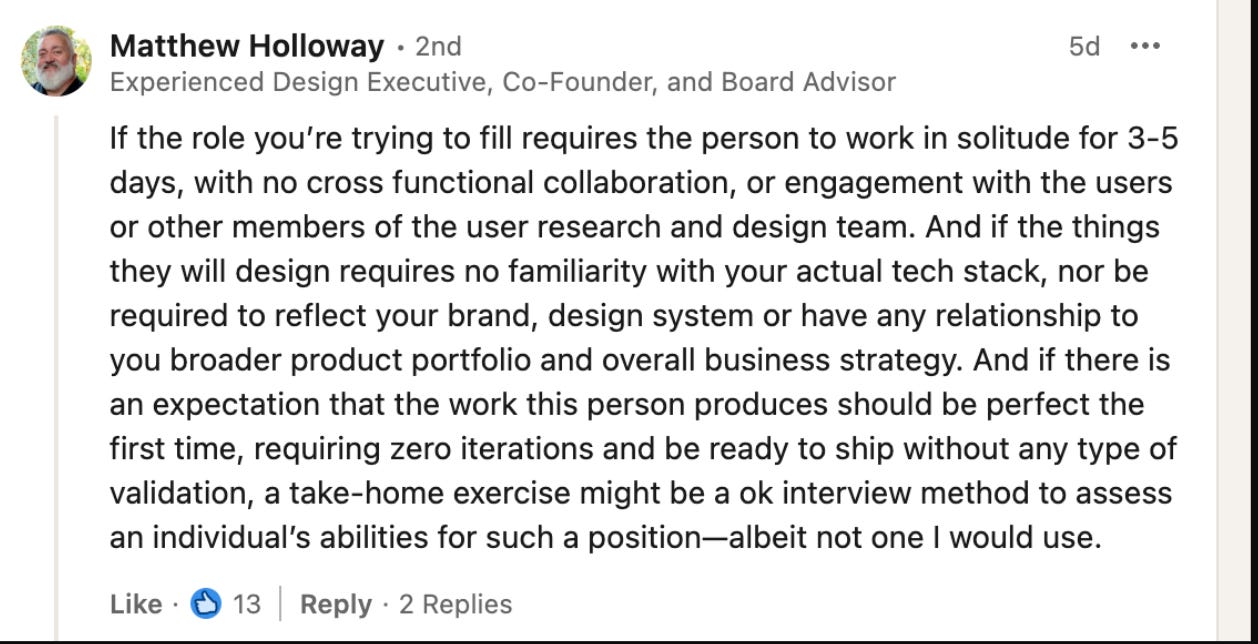When Interviews Become Exploitation
The line between testing your thinking and stealing your ideas is thinner than you think. Here's how to tell the difference.
Is it okay for a prospective employer to ask for deep strategic work during the interview process? Work that may shift the priorities of their business—whether they hire you or not?
When does the interview process become theft?
How much value are you willing to give away simply for the chance at winning the job?
And finally… have your feelings on the matter changed now that it’s 2025 and not 2021?
Christina Hamlin is a senior design leader who builds orgs at Silicon Valley’s top companies. She’s been asked to give away her best thinking—and has been in leadership roles where she’s had to request the same from others.
She’s hired hundreds.
But recently, she got burned by what she calls The Free Work Trap.
A trap she refuses to set for others.
She breaks down why it happens, when it’s justified, and how to spot the difference.
Take it away, Christina.
👋🏻 Christina Hamlin here.
Picture this: You’re deep in the interview process.
The recruiter calls feel promising, the panel conversations go well, and you have every reason to believe you’re in serious contention.
Then it shows up in your inbox:
“For the next step, we’d like you to do a collaborative whiteboard exercise solving a real-world problem we’re facing.”
Or:
“We’ll send you a take-home project to map out how you’d approach our strategy.”
Unpaid. Unbounded. And completely out of step with a senior leadership role.
Sound familiar?
I’ve seen this more times than I can count. You probably have too.
Sometimes the assignment is framed as a way to “see how you think and collaborate,” but in practice it feels like free work—work the company might use. It feels like an unfair way to make you perform under a microscope.
So let’s be clear about what’s reasonable—and what’s not.
When Portfolios Are Fair Game
Many companies ask for a portfolio, and that’s a fair ask.
As senior leaders we should be able to show our impact and tell the story of the value we’ve created. Especially design professionals, though this applies across functions.
The challenge is that portfolios have become so polished they can feel like theater—all shine, little context. They can become a caricature of your actual experience.
The expectation is that you’ll overhaul your portfolio for every interview—a tremendous ask, especially if you’re actively leading in your current role.
The best portfolio is a moving target—each time it needs to be tailored to the company, making your best guess at what will resonate, or forcing your polished use cases to mimic theirs.
They want to see that you understand their problem space. That you can provide value immediately.
Some of my peers raise a red flag when a portfolio isn’t requested—it’s become that standard in design hiring.
Done right, reviewing past work is healthy.
The problem isn’t the portfolio—it’s when companies push beyond it, into free consulting.
That’s where the trap begins.
The Free Work Trap
The trap happens when interviews shift from evaluation to extraction.
Instead of engaging in conversation, probing judgment, or testing reasoning, the process turns into unpaid deliverables: a whiteboard exercise that mirrors today’s business challenge, or a take-home strategy plan that looks suspiciously like tomorrow’s roadmap.
I want to be clear, there’s nothing wrong with testing how someone thinks.
Strong evaluators do this through structured conversations, scenario discussions, and case-based interviews.
The difference is clear.
“How would you approach building a design org of 50 people?” → A fair test of judgment.
“Draft an annual resourcing plan with 30/60/90 objectives.” → That’s not evaluation. That’s outsourcing, for free.
One evaluates your experience.
The other extracts it.
And when that becomes the norm, it’s not just unfair—it’s a preview of how little they value your time.
Why This Keeps Happening
On the company side:
Some organizations don’t trust conversations, references, or past results. Either they’re unfamiliar with interviewing for executive roles, or they’ve been burned by quick turnover.
Instead of building confidence through dialogue, they offload the burden with projects.
Ironically, it signals more about their own insecurity than your fit.
For the company, assigning a “quick exercise” is nearly free.
For you, it may mean late nights, weekends, and unpaid labor with no guarantee of return. That asymmetry is what makes it exploitative—especially when you’re up against others all vying for the same role.
On the candidate side:
When you’ve invested hours already, it’s natural to feel you should “give something back.”
Jacob would add that this is a sunk-cost fallacy.
I’ve felt that myself.
Companies can exploit this by asking for work they actually plan to use—detailed plans or revenue strategies that translate to real deliverables, whether they hire you or not.
With today’s crowded talent market, many of my peers worry that pushing back means disqualification. The hesitation is real. But the peers I’ve seen set boundaries early usually end up in roles where their judgment is valued from day one.
The fundamental problem:
Without clear definitions, no two candidates are solving the same scenario.
Each works in a vacuum, which means comparisons aren’t fair or useful. No matter how much research you do, you can never truly know what’s happening from the outside.
What looks like “better thinking” might just be better guesswork.
But Sometimes, It’s Complicated
Not every exercise is exploitation.
Sometimes, it’s more complicated than that—and our own motivations can blur the line. Sometimes it can feel like we’re burned out or demoralized in our current roles. Maybe we think finding something new will be the answer to get us reenergized.
I know you’ve been there too.
About a year ago, I was in seat leading a large design team I loved but received an inbound opportunity to interview for a senior executive design position at a well-known F500 logo.
It’s the type of opportunity that felt like it deserved everything I had.
The first conversations went really well. I clicked with the hiring manager and hit it off with everyone on the team.
Then came the message:
“We’re going to need you to do a presentation.”
The usual mental gymnastics began.
What will I need to update?
Will my stories resonate?
How do I pull this together while running my team?
But then came the twist:
“We’re going to need you to do a case study on a prompt we’ll provide to you.”
Errr… what? You’re joking.
Not only was that completely unexpected for the level of this role, it also made me wonder what I’d have to cut out of my carefully crafted narrative just to hit the time limit.
Once I got the outline of the expectations, I was shocked.
They wanted two things: a comprehensive review of their product suite, and a proposal for something big I’d want to change.
Oof.
It was a punch to the gut.
Now, I have to be honest with myself. In my own hiring processes, I require portfolio reviews and a lightweight whiteboard challenge. But I never base it on a company’s real problem. In fact, I often make it intentionally silly.
I’m not testing solutions—I’m testing thinking.
I almost said no. I should have said no. But I took it on anyway.
I didn’t want to do the work—for free—but part of me wanted to prove to myself that I could.
Maybe this is part of the lie we tell ourselves.
What should have taken “2-4 hours” ended up taking weeks over the holidays to prepare.
When the day arrived, I delivered flawlessly.
When I reached the company-specific section of the presentation, I confronted the audacity of the ask head-on—starting with a screenshot of a LinkedIn post questioning the very practice I was now participating in.
Then I dove in.
Heads nodded. Smiles appeared. When I finished, several people said, “I swear we didn’t pay her to say those things!” because I had hit on many of their pain points exactly.
It felt good. I felt validated.
I got the offer.
And then I didn’t take the job.
For a while, I thought that experience had given me closure—that I’d learned my lesson about where the line was and how to hold it.
But life has a way of testing the lessons we think we’ve mastered.
The Next Time It Happened
Not long ago, I found myself in a familiar situation—this time with a company and team I admired deeply.
From the first conversation, I felt that spark—the sense that this could be something special.
Early in the process, they were clear—no presentation, no take-home. Just thoughtful, senior-level conversations. The kind you expect when you’re being evaluated for how you think and lead, not how fast you can make slides.
But when it came down to two final candidates, the plan shifted.
They decided to add a presentation—an assessment of a product, followed by a panel Q&A.
The difference, though, was intent.
When I asked about the change, they said we were both excellent candidates who could do the job. They emphasized that it wasn’t about the output itself—it was about how I approached the problem, how I framed opportunity, how I thought.
And that resonated with me, because it’s exactly how I structure my own hiring processes.
They said, “just spend a few hours.” But we all know what that really means.
I spent closer to twenty, maybe more. Not because they asked me to—because I wanted to prove I belonged there.
I gave it everything. And when it was over, I felt proud. I hadn’t held back, I hadn’t phoned it in. I’d shown up fully.
This time, I didn’t get the offer.
And that, strangely, made it easier to see the line more clearly.
Even when intent is good, even when respect is present, the imbalance remains: candidates still invest days—sometimes weeks—of uncompensated strategic thinking to prove they belong in a room they’ve already earned the right to enter.
The difference is that now, I understand why I said yes.
What That Experience Taught Me
Sometimes we say yes to free work for reasons that have nothing to do with the company—pride, curiosity, validation, or even defiance.
And often, the company’s ask—while clumsy—isn’t malicious.
The real work is learning to tell which is which.
That’s why the Free Work Trap isn’t black and white. It’s unfair to just scoff at the ask. It’s hard, but important, to dig into it. Understand why they’re asking. Understand why you’re considering it, or not.
So many questions go through my mind each time.
Is it worth it?
Will saying no leave me in the dust when someone else says yes?
Am I supposed to just suck it up?
Will my peers or mentors think less of me?
Will saying yes perpetuate the problem?
Am I compromising my own belief system?
Am I hurting my career either way?
It’s a spectrum—one that depends on intent, clarity, and context.
Making the Choice
When that “free work” request lands, don’t just react—evaluate.
Understand the Ask
What exactly are they testing? Is it your thinking or your output? Does the scope match the seniority of the role? Ask for clarity. Ask about their intent. Those answers will help frame the right decision for you.
Understand the Balance
Is this a fair evaluation or quiet extraction? How will they use the work, and are expectations clear and consistent across candidates?
For me, when the expectations feel less like evaluation criteria and more like a project brief, that’s the red flag.
In my first story, a panelist joked about “turning my presentation into tickets for the next sprint.”
That joke stuck with me—and fed into my decision to turn it down.
In my second story, the team told me I was a strong culture fit and my assessment had been excellent. That filled me with pride—and made the rejection sting more.
Understand Yourself
Are you saying yes because you want the role, because you need the validation, or because you don’t want to risk losing momentum?
All are valid—just know which one’s driving you.
For me, I was at a point where I needed validation. I got it.
In that first case, I realized I didn’t want to work for a company that made this request of candidates. It made me wonder what the role would actually be like if I took it—would the expectations always be this far beyond reason?
Once you’ve done that, make your choice—to push back, refuse, or lean in—consciously.
Because the goal isn’t to avoid every exercise or request. It’s to stay aware of what each one reveals—about the company, and about you.
Jacob’s Take
The Free Work Trap isn’t always malicious, but it’s always revealing.
You may have heard my hot take on this before—If you’re competing for a several-hundred-thousand to million-dollar-plus role, who cares what they ask of you? If you don’t do it, someone else will. Go after it and quit complaining.
I’m not proud of that now. I dismissed it as a champagne problem, a first-world complaint.
After working with hundreds of overworked, overstretched, in-demand leaders—and becoming a father of two boys—I’ve changed my tune.
I value your time and mine far more now.
Companies that respect your time in interviews will respect your judgment after. The ones extracting free labor before you have the job?
That’s your preview.
But that doesn’t mean you should give up.
The bumps and bruises you collect during the interview process? They become leverage in your negotiation later. Your experience is an opportunity—not to throw stones, but to push for better hiring practices once you’re inside. To be the leader who refuses to perpetuate the trap.
Sometimes we say yes because we need validation more than the role.
I’ve done it. Maybe you have too.
Next time you get that “quick exercise” request, pause. Ask Christina’s three questions:
What are they testing?
Is this fair, or extraction?
Why am I really saying yes?
Then decide—eyes wide open.
Drop your Free Work Trap stories in the comments or connect with Christina Hamlin or Jacob Warwick on LinkedIn to share in private.
Need help applying this? Upgrade to paid for monthly live sessions with Jacob.
Stay fearless, friends.










